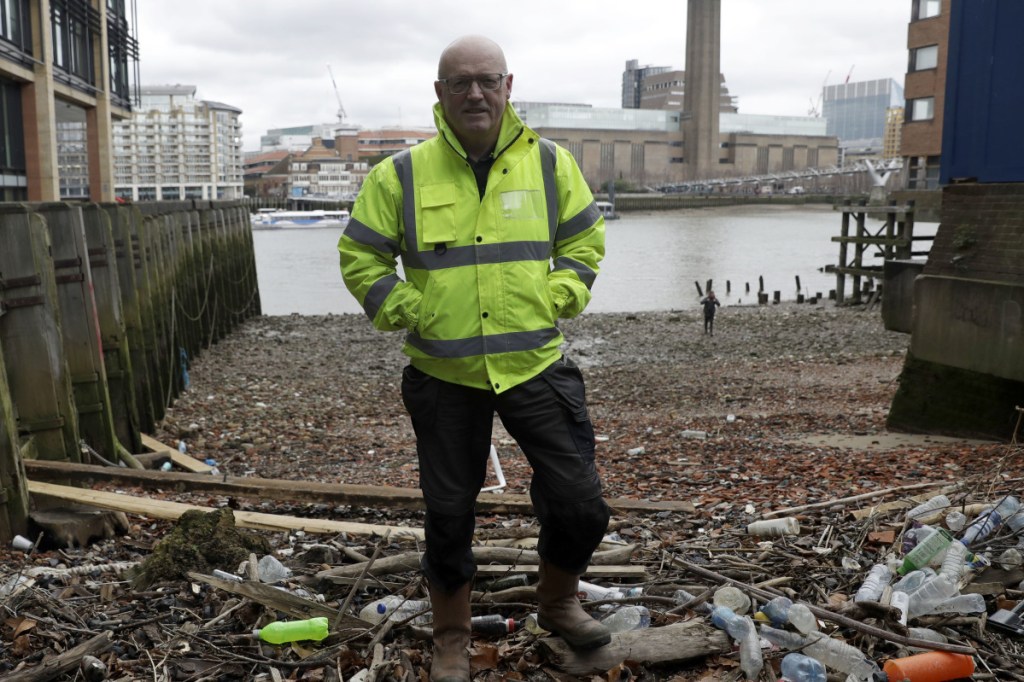LONDON — Once a month, accountant Michael Byrne pulls on his rubber boots and makes his way to a spot on the banks of the River Thames.
He carefully marks out an 11-square-foot patch and catalogs each bit of plastic he finds, meticulously reporting the data to the environmental group Thames21. On Aug. 20, for example, he and other volunteers found an average of 31 food wrappers, the sticks from 29 cotton swabs, 12 bottle tops and about 100 pieces of small chewed up plastic in each patch.
“We are the data gatherers” who provide evidence of the plastic that’s clogging the world’s rivers and oceans, he said.
Public awareness of the problem of plastic waste is swelling after alarming forecasts that there could be more plastic than fish in the oceans by 2050.
And where consumers’ attention goes, so does that of companies.
In the last few months, Amcor, Ecover, Evian, L’Oréal, Mars, M&S, PepsiCo, Coca-Cola, Unilever, Walmart and Werner & Mertz – which together use more than 6 million metric tons of plastic packaging per year – have committed to using only reusable, recyclable or compostable packaging by 2025, according to the Ellen MacArthur Foundation, an innovation think tank.
Adidas, meanwhile, is making a line of clothing from recycled plastic bottles and promoting the products with an online video underscoring the health threat to humans of ingesting plastic particles found in fish. Negozio Leggero, a high-end food store in Italy and Switzerland, features 1,500 package-free products. British supermarket chain Iceland is planning to remove all plastic packaging from its own-brand products by 2023.
“Some of the companies that might have been seen as the worst offenders are the ones moving forward,” said Abigail Entwistle of Fauna & Flora International, a 115-year-old conservation organization. “They have the most to lose.”
These are the companies, after all, that have profited from a business model that wraps everything from spring water to cleaning products in plastic packaging that is used once and thrown away.
The Ellen MacArthur Foundation highlighted the issue last year in a report that said the weight of plastic in the oceans would equal that of fish by 2050 if current trends continue. Only 14 percent of plastic packaging is currently collected for recycling, according to the foundation, which works with companies like Google, Nike and Danone. Action is needed on multiple fronts, it says.
“It’s not about one innovation, one regulation, one action. We need all of them at the same time.” Rob Opsomer, who leads the foundation’s New Plastics Economy project. “We need to have more and bolder ambitions.”
Market research group Mintel says we may eventually see “social stigmatization” of plastic cups and cling film, with firms developing soluble packaging and more retailers shunning products encased in plastic.
“There is money to be made, but more importantly there’s money to be lost,” said Ben Punchard, global packaging analyst at Mintel. “It is being used as a virtue signal. It’s showing you are doing the right thing.”
Byrne continues trying to spread the word.
The accountant has 60 sets of rubber boots to loan to anyone who joins him on the banks of the Thames. He gives everyone a safety briefing, and there’s a promise of an afternoon at the pub after the grueling work of trash counting and pickup.
“We have a problem with plastic,” he said. We have to do something.”
Send questions/comments to the editors.



Success. Please wait for the page to reload. If the page does not reload within 5 seconds, please refresh the page.
Enter your email and password to access comments.
Hi, to comment on stories you must . This profile is in addition to your subscription and website login.
Already have a commenting profile? .
Invalid username/password.
Please check your email to confirm and complete your registration.
Only subscribers are eligible to post comments. Please subscribe or login first for digital access. Here’s why.
Use the form below to reset your password. When you've submitted your account email, we will send an email with a reset code.